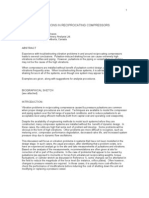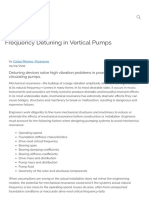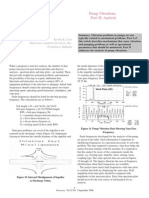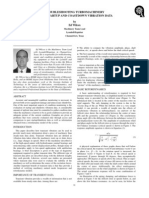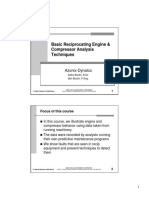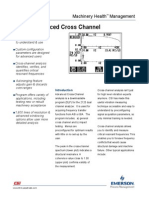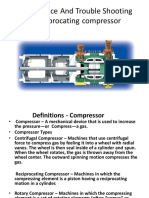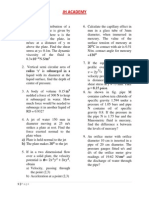Vibration Analysis of Pump
Vibration Analysis of Pump
Uploaded by
vijayabaskaran PalanisamyCopyright:
Available Formats
Vibration Analysis of Pump
Vibration Analysis of Pump
Uploaded by
vijayabaskaran PalanisamyOriginal Title
Copyright
Available Formats
Share this document
Did you find this document useful?
Is this content inappropriate?
Copyright:
Available Formats
Vibration Analysis of Pump
Vibration Analysis of Pump
Uploaded by
vijayabaskaran PalanisamyCopyright:
Available Formats
CENTRIFUGAL PUMPS
USING VIBRATION ANALYSIS TO DETECT PROBLEMS
PRINCIPLES OF OPERATION:
Centrifugal pumps are among the more versatile and widely used pieces of rotating mechanical
equipment found today. Pumps are essential in almost all utilities services and power generation
plants. It is estimated that pumps consume approximately 31% of rotating equipment electrical
power used throughout industry. Pumps are a vital part of our lives on the planet today.
The basic principal of operation for a centrifugal pump is that a shaft mounted rotating impeller
inside a housing (volute) imparts energy to the fluid being moved. Centrifugal pumps utilize
centrifugal force (thus their name) to increase the velocity of the fluid as it passes through the
impeller and exits at the tip or periphery of the impeller. This action converts mechanical energy
(shaft torque) into kinetic energy by acceleration of the fluid to a higher velocity and pressure
(potential energy).
PUMP PERFORMANCE:
Pumps follow basic laws of performance. These are useful in determining the effect of changes to
the operating parameters and can help determine the cause of operational problems. These basic
laws apply to most centrifugal pumps or pump systems.
1. Fluid flow (quantity) varies directly with the impeller rotating speed or diameter change.
2. Head generated (feet of head) varies with the square of the impeller tip speed (ft/sec)2
divided by 64.4 (2g, ft/sec2).
3. Horsepower varies directly with the volume and specific gravity of the fluid pumped.
4. Horsepower varies with the cube of a change in rotating speed or impeller diameter.
DETECTING PUMP PROBLEMS USING VIBRATION ANALYSIS:
Centrifugal pumps are subjected to operational forces generated by their operating speed, system
head, pressure and piping arrangement. These operational forces cause forced vibration and may
originate from the rotating parts or operating conditions (flow quantity, pressures, speed and
arrangement). This vibration reduces the expected life of the pump bearings and other
components.
SUMMARY OF COMMON PUMP VIBRATION PROBLEMS:
(Detected Using Vibration Analysis)
1. Cavitation:
Cavitation typically generates random, higher frequency broadband energy, which is
sometimes superimposed with blade pass frequency harmonics (multiples). Cavitation is a
symptom of insufficient net positive suction head (NPSH). Cavitation results when the
absolute pressure of the liquid at the pump impeller inlet approaches the vapor pressure of
the liquid causing vapor pockets to form and collapse (implode) as they pass through the
pump impeller. The collapsing of the vapor bubbles can be very destructive and may
© Copyright 2014 Technical Associates of Charlotte, P.C. Page 1
www.technicalassociates.net
CENTRIFUGAL PUMPS
USING VIBRATION ANALYSIS TO DETECT PROBLEMS
damage the pump and impeller. When present, cavitation often sounds as if “marbles” or
“gravel” are passing through the pump. The positive suction head required to correct
suction cavitation is known as “NPSHR” (Net Positive Suction Head Required). This value
is typically supplied by the pump manufacturer.
2. Pump Flow Pulsation:
Pump flow pulsation is a condition that develops when a pump is operating near its shut-off
head. The vibration in the time waveform will be sinusoidal. In addition, the spectra will still
be dominated by 1X RPM and blade pass frequency. However, these peaks will be
unstable, increasing and decreasing as the flow pulsation occurs. Pressure gauges on the
discharge piping will fluctuate up and down. If the pump has a discharge swing check
valve, the valve arm and counter-weight will bounce back and forth indicating unstable flow.
3. Bent Pump Shaft:
Bent shaft problems cause high axial vibration with axial phase differences tending towards
180° on the same rotor. Dominant vibration normally occurs at 1X RPM if bent near shaft
center, but at 2X RPM if bent near the coupling. Pump bent shafts are more common at or
near the coupling. Dial indicators can be used to confirm a bent shaft.
4. Unbalance of Pump Impeller:
Pump impellers should be precision balanced at the pump original equipment manufacturer
(OEM). This is particularly important since forces due to unbalance greatly affect life of the
pump bearings (bearing life varies inversely with the cube of imposed dynamic load). The
pump may have a center-hung or an overhung impeller. If the impeller is center-hung, force
unbalance often predominates over couple unbalance. In this case, highest vibration will
typically be in the radial (horizontal and vertical) direction. The highest amplitude will be at
the pump operating speed (1X RPM). In this case of force unbalance, the horizontal
outboard and inboard phase will be about the same (+/- 30°), as will the vertical phase. In
addition, there is usually about a 90° difference in horizontal and vertical phase on each
pump bearing (+/- 30°). Center-hung impellers, by their design, have balanced axial forces
on the inboard and outboard bearings. Elevated axial vibration is a strong indication of
pump impeller obstruction by foreign objects causing the axial vibration typically at running
speed to increase.
If the pump has an overhung impeller, this will usually cause high 1X RPM in both the axial
and radial directions. Axial readings tend to be in-phase and steady, whereas radial phase
readings might be unsteady. Overhung rotors have both force and couple unbalance, each
of which will likely require correction. Thus, correction weights will most always have to be
placed in 2 planes to counteract both force and couple unbalance. In such cases, it will
most always be necessary to remove the pump rotor and place it on a balance machine to
balance it to sufficient precision since 2 planes will not normally be accessible in the field.
5. Shaft Misalignment:
Shaft misalignment is a condition found on direct drive pumps where the centerlines of two
coupled shafts are not coincident. Parallel misalignment is a condition where the shaft
centerlines are parallel but offset from one another. The vibration spectrum often will show
2X higher than 1X and a 3X higher than normal with 180° out of phase across the coupling
© Copyright 2014 Technical Associates of Charlotte, P.C. Page 2
www.technicalassociates.net
CENTRIFUGAL PUMPS
USING VIBRATION ANALYSIS TO DETECT PROBLEMS
in the radial direction. Angular misalignment will show high axial 1X with some 2X and 3X
and a 180° phase shift axially across the coupling.
6. Pump Bearing Problems:
Peaks (with harmonics) at nonsynchronous frequencies is a symptom of rolling element
bearing wear. Short bearing life for pumps is typically the result of poor bearing selection
for the application, such as excessive loads, poor lubrication or high temperatures. If the
model number and manufacturer of the bearings are known, then the specific fault
frequencies for the outer race, inner race, rolling elements and cage can be determined.
These fault frequencies for such bearings are found within tables of most predictive
maintenance (PdM) software today.
Centrifugal pumps have unique problems due to the operational conditions to which they are
subjected that are not common to other machine types. These problems (or faulty conditions) can
then generate some unique vibration spectra and time waveforms as outlined above. This article is
intended to be a summary of common pump problems that vibration analysis can detect and
identify. If reliability technicians obtain the proper vibration training they need that instructs them
how to identify such problems and faulty operating conditions, they can utilize vibration analysis to
identify each of the aforementioned problems (and other faults) before they result in failure. In turn,
this will provide considerable savings in maintenance and operations expenditures if such
problems are detected during early stages preventing catastrophic failure and causing loss of
production and downtime. Studies have shown that centrifugal pumps are some of the most
common machine types in use throughout virtually all industry types. The key to detecting and
resolving such problems on centrifugal pumps is obtaining vibration analysis training from
instructors who themselves have considerable vibration expertise, specifically with these particular
machines. Technical Associates is one of several organizations offering vibration training on
centrifugal pumps. Not only do they provide instruction on how to detect such faults using vibration
signature analysis, but also how to apply time waveform analysis on these unique machine types.
In addition, most training service providers offer vibration analysis certification through a written
examination as confirmation of the student’s comprehension of the course material and the basics
for detecting common pump problems using vibration analysis.
James David Kesler
Sales/Operations Manager
Technical Associates of Charlotte
1230 West Morehead St., Suite 400
Charlotte, NC 28208
© Copyright 2014 Technical Associates of Charlotte, P.C. Page 3
www.technicalassociates.net
You might also like
- Shaft Coupling and AlignmentDocument17 pagesShaft Coupling and AlignmentKiddos GardenerNo ratings yet
- Vibration in Pumps PDFDocument5 pagesVibration in Pumps PDFonspsnonsNo ratings yet
- Pump Condition Monitoring Through Vibration AnalysisDocument20 pagesPump Condition Monitoring Through Vibration AnalysisIgor Juric100% (3)
- Manual IRD 258Document72 pagesManual IRD 258Jaime GonzálezNo ratings yet
- Solving Motor Vibration Problems On Vertical Pumps ResonanceDocument5 pagesSolving Motor Vibration Problems On Vertical Pumps Resonancejameel babooramNo ratings yet
- Diagnosis of Centrifugal Pump Faults Using Vibration MethodsDocument12 pagesDiagnosis of Centrifugal Pump Faults Using Vibration MethodsHatem ShawkiNo ratings yet
- Pumps and SystemsDocument5 pagesPumps and SystemsYashwant Kumar Saini100% (2)
- Field Balancing and Vibration Reduction of Large Power Generation Steam TurbinesDocument31 pagesField Balancing and Vibration Reduction of Large Power Generation Steam TurbinesAbdulrahman Alkhowaiter100% (2)
- Belt Installation and MaintenanceDocument6 pagesBelt Installation and Maintenancefaizan abbasiNo ratings yet
- Case Study Tuning Out Difficult Torsional Vibration ProblemDocument15 pagesCase Study Tuning Out Difficult Torsional Vibration Problempathakshashank100% (1)
- Technical Paper-Turbine Vibration NathDocument5 pagesTechnical Paper-Turbine Vibration NathHimansu GoswamiNo ratings yet
- Shaft Alignment PracticeDocument2 pagesShaft Alignment Practicekamal arabNo ratings yet
- Viberation and Noise in Centrifugal PumpsDocument12 pagesViberation and Noise in Centrifugal PumpsFahad MaqsoodNo ratings yet
- Detection of Unbalance in Rotating Machines Using PDFDocument14 pagesDetection of Unbalance in Rotating Machines Using PDFKonstantinos KamarasNo ratings yet
- Monitoring and Analysis of Machine VibrationDocument6 pagesMonitoring and Analysis of Machine VibrationAvinashNo ratings yet
- Vibrations in Reciprocating CompressorsDocument15 pagesVibrations in Reciprocating Compressorschaitanya_kumar_13100% (1)
- Vibration Based Damage Detection (VBDD) - Case StudyDocument16 pagesVibration Based Damage Detection (VBDD) - Case StudyAshokNo ratings yet
- Identification of Torsional Vibration Features in Electrical Powered Rotating EquipmentDocument9 pagesIdentification of Torsional Vibration Features in Electrical Powered Rotating EquipmentHasan PashaNo ratings yet
- CO2 Compressor Reverse RotationDocument8 pagesCO2 Compressor Reverse RotationHoang ThangNo ratings yet
- Torsional Vibration Analysis of Synchronous Motor Driven TCDocument16 pagesTorsional Vibration Analysis of Synchronous Motor Driven TCBharath Chandra ReddyNo ratings yet
- Virgin Islands - Final1Document51 pagesVirgin Islands - Final1ejzuppelli8036No ratings yet
- Frequency Detuning in Vertical Pumps - Pumps & Systems PDFDocument9 pagesFrequency Detuning in Vertical Pumps - Pumps & Systems PDFskakerNo ratings yet
- Revamps Reciprocating CompressorDocument12 pagesRevamps Reciprocating Compressorkumsan lee100% (1)
- System1 Plots - Machinery-Diagnostic - Part1Document16 pagesSystem1 Plots - Machinery-Diagnostic - Part1Thyagaraju PalisettyNo ratings yet
- T19101 118Document18 pagesT19101 118Chintan Raval100% (2)
- Engine Pedestal Vibration - A New Solution Approach Using A Tuned-Mass Damper - R00Document22 pagesEngine Pedestal Vibration - A New Solution Approach Using A Tuned-Mass Damper - R00Kelly Eberle100% (1)
- Chapter 10Document63 pagesChapter 10Hosam Abd Elkhalek100% (2)
- CSI AccessoriesDocument2 pagesCSI AccessoriesDia Putranto Harmay100% (1)
- Windrock CalculationsDocument8 pagesWindrock CalculationsManuel Otero AlzaNo ratings yet
- Recommended Approach To Control Vibration From Cylinder Gas ForcesDocument14 pagesRecommended Approach To Control Vibration From Cylinder Gas ForcesKelly Eberle100% (1)
- Balancing Without PhaseDocument2 pagesBalancing Without PhasevahidyasharNo ratings yet
- Correlation Between Belt Natural Frequencies and Vibration SpectraDocument7 pagesCorrelation Between Belt Natural Frequencies and Vibration SpectraSrinivasan RaviNo ratings yet
- Vibration Report For The Vapor Compressor of Desalination Unit B (59ML04B-MJ01)Document8 pagesVibration Report For The Vapor Compressor of Desalination Unit B (59ML04B-MJ01)FadooollNo ratings yet
- Learn About Vibration: Volume 2: Advanced Vibration AnalysisDocument24 pagesLearn About Vibration: Volume 2: Advanced Vibration Analysisamekhzoumi100% (1)
- Advanced Plots WorkshopDocument52 pagesAdvanced Plots WorkshopfazzlieNo ratings yet
- Diffuser Versus Volute Casing - PumpsDocument5 pagesDiffuser Versus Volute Casing - Pumpsjanamurali0% (1)
- FRF VibrationDocument29 pagesFRF VibrationTheerayootNo ratings yet
- Rotor Instability Morton Effects in MachineryDocument0 pagesRotor Instability Morton Effects in Machineryilmu2No ratings yet
- EM 81 - Pump Vibrations Part IIDocument2 pagesEM 81 - Pump Vibrations Part IIΡαφαηλ Καμ.100% (1)
- Vibration SwitchesDocument12 pagesVibration SwitchesAnonymous 1dVLJSVhtrNo ratings yet
- CEP VFD ManualDocument234 pagesCEP VFD ManualUsama ZubairNo ratings yet
- Troubleshooting Turbomachinery Using Startup and Coastdown Vibration DataDocument14 pagesTroubleshooting Turbomachinery Using Startup and Coastdown Vibration DataAhtsham AhmadNo ratings yet
- ARLA Rotor Dynamics Seminar 1Document3 pagesARLA Rotor Dynamics Seminar 1cwfh779No ratings yet
- Resolving Structural Vibration Issue On A Water Flood PumpDocument22 pagesResolving Structural Vibration Issue On A Water Flood Pumpdachrydax100% (1)
- 4 BasicEngineandCompressorAnalysis PDFDocument133 pages4 BasicEngineandCompressorAnalysis PDFalvaroinc04No ratings yet
- Guidelines 0n Pump Vibration First Edition Final July 2013Document17 pagesGuidelines 0n Pump Vibration First Edition Final July 2013ridzim4638No ratings yet
- 2008 Experience With Rotor-Stator Interactions in High Head Francis RunnerDocument10 pages2008 Experience With Rotor-Stator Interactions in High Head Francis RunnerAlexandre TrudelNo ratings yet
- Windrock Short Presentation 4-2011Document12 pagesWindrock Short Presentation 4-2011Mauricio Javier DuranNo ratings yet
- TOMAS UsersManualDocument94 pagesTOMAS UsersManualrodruren01No ratings yet
- Turbo Machinery Fault SummaryDocument19 pagesTurbo Machinery Fault SummaryAlexander Jose Hernandez AcunaNo ratings yet
- Peakvue Case History 2Document9 pagesPeakvue Case History 2ben_ramatlaNo ratings yet
- Balanceo Rodamiento VidaDocument6 pagesBalanceo Rodamiento VidaManel MontesinosNo ratings yet
- VibMatters-August 2016 PDFDocument6 pagesVibMatters-August 2016 PDFshakerNo ratings yet
- Motor Vibration Analysis - Keeping It SimpleDocument2 pagesMotor Vibration Analysis - Keeping It SimplebwelzNo ratings yet
- CMRP Exam - Best Practices of Maintenance and Reliability - UdemyDocument11 pagesCMRP Exam - Best Practices of Maintenance and Reliability - UdemySantosh NathanNo ratings yet
- Time Waveform Analysis TechniquesDocument2 pagesTime Waveform Analysis TechniquesManel Montesinos50% (2)
- Advanced Cross Channel Analysis ProgDocument4 pagesAdvanced Cross Channel Analysis Progsatya_chaganti100% (1)
- Vibration of Overhung RotorsDocument11 pagesVibration of Overhung RotorsAri HaranNo ratings yet
- Centrifugal Pump Health Check Up 1691257011Document35 pagesCentrifugal Pump Health Check Up 1691257011Luis MarshNo ratings yet
- Centrifugal Compressor Disaster-Explosion Texas A-M PaperDocument19 pagesCentrifugal Compressor Disaster-Explosion Texas A-M Papervijayabaskaran PalanisamyNo ratings yet
- A Beginners TutorialDocument56 pagesA Beginners Tutorialvijayabaskaran PalanisamyNo ratings yet
- Business Comunication BUCODocument220 pagesBusiness Comunication BUCOvijayabaskaran PalanisamyNo ratings yet
- Best Practice in Process Pump Maintenance & ReliabilityDocument18 pagesBest Practice in Process Pump Maintenance & Reliabilityvijayabaskaran Palanisamy100% (1)
- Articles From HP Magazine-November 2021 EditionDocument14 pagesArticles From HP Magazine-November 2021 Editionvijayabaskaran Palanisamy100% (1)
- 101 Ways To Motivate EmployeesDocument7 pages101 Ways To Motivate Employeesvijayabaskaran PalanisamyNo ratings yet
- Roni Specific Latent Heat WorksheetDocument3 pagesRoni Specific Latent Heat WorksheetmuzbegsNo ratings yet
- Che 456 Spring 2007 Major 2 Production of Formalin: BackgroundDocument6 pagesChe 456 Spring 2007 Major 2 Production of Formalin: BackgroundJosselyn VilcaNo ratings yet
- Chapter 4chamDocument33 pagesChapter 4chamhoangvubui4632No ratings yet
- MP RoomDocument1 pageMP RoomArun FikdetcNo ratings yet
- 2.B Aeration Process - 21CV43Document4 pages2.B Aeration Process - 21CV43Javeriya JaveriyaNo ratings yet
- ScaDocument16 pagesScaAndres CarrascoNo ratings yet
- 3rd - Sem-Ct-23-Chemical EngineeringDocument3 pages3rd - Sem-Ct-23-Chemical EngineeringJay RanjanNo ratings yet
- SYS-APM001-En Chiller System Design and ControlDocument2 pagesSYS-APM001-En Chiller System Design and ControlAtiqNo ratings yet
- 9878flow Measuring DeviceDocument18 pages9878flow Measuring DeviceBagadi AvinashNo ratings yet
- HT QSTNS PDFDocument2 pagesHT QSTNS PDFMannam Sarath SarathNo ratings yet
- MeasurIT Flexim Application Data Sheet FLUXUS 0811Document2 pagesMeasurIT Flexim Application Data Sheet FLUXUS 0811cwiejkowskaNo ratings yet
- Air Cooled Heat Exchangers: Gas Storage PlantDocument1 pageAir Cooled Heat Exchangers: Gas Storage PlantvamcodongNo ratings yet
- 12hoist4u - Guidelines For The Safe Use of Taglines 4Document1 page12hoist4u - Guidelines For The Safe Use of Taglines 4dunglxNo ratings yet
- Development of Extrusion Instabilities and Surface IrregularitiesDocument37 pagesDevelopment of Extrusion Instabilities and Surface IrregularitiesnycyellowNo ratings yet
- OCTOBER 20,2020: Assignment 06Document5 pagesOCTOBER 20,2020: Assignment 06Sarthak PatelNo ratings yet
- Trane Air-To-Water HP Application GuideDocument28 pagesTrane Air-To-Water HP Application GuideCarlos Neto100% (1)
- 2017 Modelling and Transient Simulation of Water Flow in Pipelines Using WANDA Transient SoftwareDocument10 pages2017 Modelling and Transient Simulation of Water Flow in Pipelines Using WANDA Transient SoftwareJuancito ZcNo ratings yet
- Spreadsheet - Gas Blanketed Tanks - Outbreathing Process Calculations & Control Valve Sizing - Rev2Document24 pagesSpreadsheet - Gas Blanketed Tanks - Outbreathing Process Calculations & Control Valve Sizing - Rev2venkatesh801No ratings yet
- Chemical Engineering Science: Valery A. Danilov, Gunther KolbDocument10 pagesChemical Engineering Science: Valery A. Danilov, Gunther KolbIvan Jahuira CervantesNo ratings yet
- UPDA Mech - Pumps - NFPA - General Question-Session 3 PDFDocument60 pagesUPDA Mech - Pumps - NFPA - General Question-Session 3 PDFSuresh SubbarayanNo ratings yet
- Engineering Utilities 2: Engr. Ervin John D. Melendres InstructorDocument24 pagesEngineering Utilities 2: Engr. Ervin John D. Melendres InstructorStephanie CanibanNo ratings yet
- Hazard Analysis PDFDocument74 pagesHazard Analysis PDFAnonymous voA5Tb0No ratings yet
- Test On Fluid MechanicsDocument11 pagesTest On Fluid MechanicsJonathan GreenNo ratings yet
- 14th Storey Sanitary BOQDocument3 pages14th Storey Sanitary BOQAILA TABRILLANo ratings yet
- Ecotank PresentationDocument16 pagesEcotank PresentationFelix SaavedraNo ratings yet
- Manual KKT MedixxDocument106 pagesManual KKT MedixxAtencion Clientes100% (1)
- Khamees 2018Document27 pagesKhamees 2018VeronicaNo ratings yet
- Hygienic DesignDocument18 pagesHygienic DesignJosé Luis García PérezNo ratings yet
- A320 Ramp and Transit Ata 28 - Fuel Metric UnitsDocument184 pagesA320 Ramp and Transit Ata 28 - Fuel Metric UnitsCassiano CapellassiNo ratings yet
- Diva Company Profile - 2023Document10 pagesDiva Company Profile - 2023The Sur StudioNo ratings yet
















